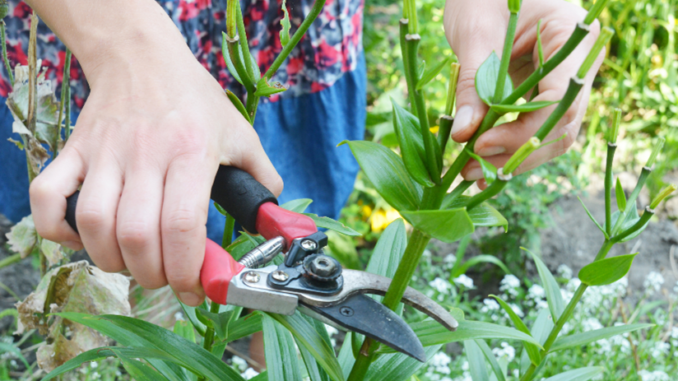
Rita Jokerst, Horticulturist, Gardens on Spring Creek
Deadheading is the removal of faded or spent flowers from a plant, usually with scissors, hand pruners, or sometimes just your forefinger and thumb. Some plants may need only the flower head removed while others may need to trim or shear further back on the plant to affect its shape, size, or branching.
Flowers are reproductive organs that serve to attract pollinators, thereby improving seed production. However, producing seeds requires lots of energy, and when a plant devotes energy to that process, other plant processes may diminish, including blossom production. Mostly commonly discussed within the context of annual flower displays, deadheading can be useful through your garden, on many perennials, and edible crops as well.
For annual flowers, the simple act of deadheading accomplishes so much in just one task. First, it keeps your plants producing plenty of blooms to the end of the season thus extending your seasonal beauty. Second, it improves overall appearance. Browning, wilted flowers detract from your oh-so-carefully-curated display. Gently picking off these faded flowers will keep your annuals looking clean, bright, and well kept.
Deadheading can also prevent unsightly foliage. Some faded flowers fall on their own foliage and stick, rotting in place. Finally, deadheading can also help you have the best-looking display right when you want it. At the Gardens, I like to do a sweep through our displays a couple of days before any of our big events. This ensures poor-looking flowers are gone and about-to-pop buds are encouraged to go on display right when we want them blooming.
It’s best to deadhead in the cool of the evenings to give your plants a handful of hours to recover when least taxed. The cool of the morning is the second-best time, but the nice thing about deadheading is that it can be done a little here and a little there. Any amount of deadheading will be rewarded, but I shoot for weekly deadheading at the Gardens.
The one exception is in the case of those plants whose flowers open in the daytime and close at night or on cloudy days. Inadequately trained dead headers may clip off still-beautiful blooms that are just closed if they are not familiar with this phenomenon. Gazanias are a great example of blooms that may just be closed rather than spent.
Sometimes deadheading isn’t about keeping the blooms going though, as is the case for lots of perennials, shrubs, grasses, bulbs, and edible crops. Many, many plants just won’t give you another late-season display, no matter how much deadheading you do. Removing flower buds can still accomplish important garden maintenance though. Almost all plants blooming at transplanting should have their flowers removed. This allows the plant to focus its energy toward establishing a quality root system and sturdy aboveground growth. Later in the season, deadheading spent ornamental bulbous plants, like lilies, helps these plants put their photosynthetic energy back into their own bulbs, ensuring a good display the following year. For prolific self-seeders, deadheading can be important if you do not wish to be awash in unwanted seedlings the following year. Selectively removing young, unlikely-to-produce flowers on some edible crops toward the end of the season allows plants to dedicate energy to more mature fruits, thereby improving your overall harvest quality.
Get snipping today for a more beautiful, more manicured garden.
Support Northern Colorado Journalism
Show your support for North Forty News by helping us produce more content. It's a kind and simple gesture that will help us continue to bring more content to you.
BONUS - Donors get a link in their receipt to sign up for our once-per-week instant text messaging alert. Get your e-copy of North Forty News the moment it is released!
Click to Donate
